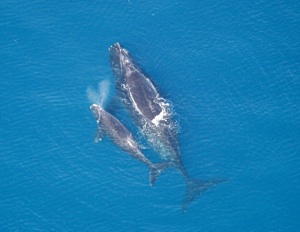Marine Mammal Species Description
North Atlantic Right Whale
Eubalaena glacialis

Photo credit: NOAA/NMFS NOAA News
Classification
Order: Cetacea
Family: Balaenidae
Alternate Common Names:
Status: ESA Endangered / MMPA Depleted
Description:
Length: 56 ft (17 m); maximum: 59 ft (18 m)
Weight: 132,280-220,460 lbs (60,000-100,000 kg); maximum: 234,790 lbs (106,500 kg)
Northern Atlantic right whales have a strongly curved upper and lower jaw and do not have any dorsal fin. These whales are in the suborder Mysticeti, or the baleen whales. Baleen whales do not have teeth, but have plates attached to their upper jaws. These baleen plates are hard, but flexible, which baleen whales use to filter their food from the water. They are black overall, commonly with a white patch on their belly. They have callosities, or callus-like patches, on their heads. Callosities are areas of thickened and hardened patches of skin that are gray in color. These callosities typically have colonies of whale lice, which look like white patches over parts of these whales' heads.
Habitat:
These whales use warmer, shallower coastal waters for calving and may use cooler, deeper water for feeding in areas where food is abundant. They can dive up to 1,000 ft (305 m) for about 40 minutes at a time. here
Feeding:
North Atlantic right whales eat mostly copepods, a type of zooplankton, and other small crustaceans (krill) and invertebrates. They commonly 'skim' their food by moving near the surface scooping them up in their large mouths and straining the water from the food using their baleen. They also dive to capture food. They dive for 10-20 minutes at a time, apparently very close to the bottom, because some individuals will surface with mud from the bottom on their head. North Atlantic right whales feed in the spring, summer, and fall in the northern areas of their range along the continental shelf where food is abundant and concentrated.
Reproduction:
North Atlantic right whales migrate south to the coasts of the southeastern United States to their calving grounds. The western Atlantic Ocean breeding ground is a relatively small area off the coast of Georgia and Florida with relatively shallow depths, 43-49 ft (13-19 m). They are typically on the calving grounds from December to March. Female right whales become sexually mature around 4-10 years old. Although females may have calves as early at 5 years old, typically they are closer to 9 or 10 years old when they have their first calf. Males become sexually mature at a length of about 49 ft (15 m), around 5-10 years old. Females mate with multiple males and their gestation period lasts around 12 months. Females have young every 3-4 years and they nurse their calf for about 12 months.
Other:
Right whales (Eubalaena spp.) were likely given their common name because they were considered the right whale to hunt. They have a lot of oil and 'whalebone', they are slow swimmers, and they commonly floated when they died. This is one of the most endangered whale species in the world. It was estimated that only 70 reproductive females existed in 1998. The current population is estimated at 300-350 individuals in the western Atlantic. Because of the calving grounds being so close to shore in an area with heavy ship traffic, ship strikes pose a serious threat to North Atlantic right whales. The longest lifespan of North Atlantic right whales is documented to be around 70 years, although this age was estimated from sightings through time of a single individual.
Distribution / Range:
The North Atlantic right whale occurs in the Northern Atlantic. There is a possibility that this species may no longer occur in the eastern North Atlantic because of population declines, caused by commercial whaling. It is believed that the majority or all of the remaining North Atlantic right whales live off the eastern coast of North America. This species typically uses a winter calving ground off the coasts of Florida and Georgia, United States, and summers farther north.
Similar species:
The most similar species are the other right whales, Northern Pacific right whale, E. japonica, and Southern right whale, E. australis. The ranges of the right whales do not overlap. Another similar species that does overlap in range with the North Atlantic right whales are bowhead whales, Balaena mysticetus. The right whales are the only whales with callosities on their head.
Notes:
References:
American Cetacean Society. 2004. American Cetacean Society Fact Sheet. http://www.acsonline.org/factpack/RightWhale.htm. Accessed January 2012.
Kenney, R.D. 2009. Right Whales - Eubalaena glacialis, E. japonica, and E. australis In: Encyclopedia of Marine Mammals 2nd Ed. Perrin W.F., B. Würsig, and J.G.M. Thewissen, eds. Academic Press, New York, pp. 962-972.
Potter, C.W. and B. Birchler. 1999. Northern right whale, Eubalaena glacialis. In The Smithsonian Book of North American Mammals. Wilson, D.E. and S. Ruff, eds., 241-243. Smithsonian Institution in association with the American Society of Mammologists, Washington DC.
Reilly, S.B., Bannister, J.L., Best, P.B., Brown, M., Brownell Jr., R.L., Butterworth, D.S., Clapham, P.J., Cooke, J., Donovan, G.P., Urbán, J. & Zerbini, A.N. 2008. Eubalaena glacialis. In: IUCN 2011. IUCN Red List of Threatened Species. Version 2011.2. www.iucnredlist.org. Downloaded on 09 January 2012.

 Marine Mammals of Georgia
Marine Mammals of Georgia